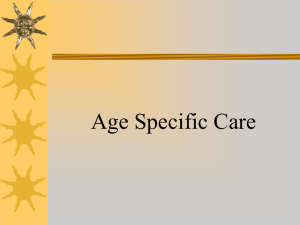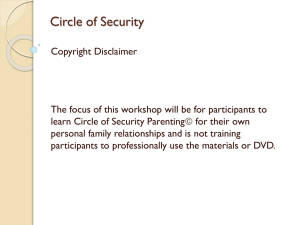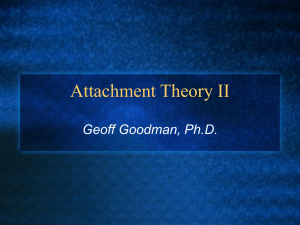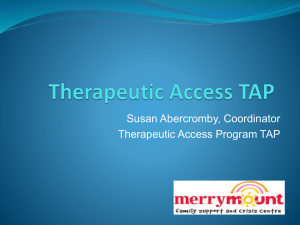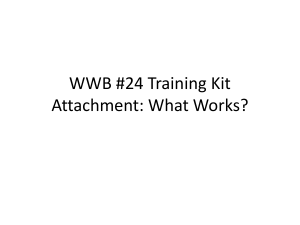Attachment and Peer Competence
advertisement
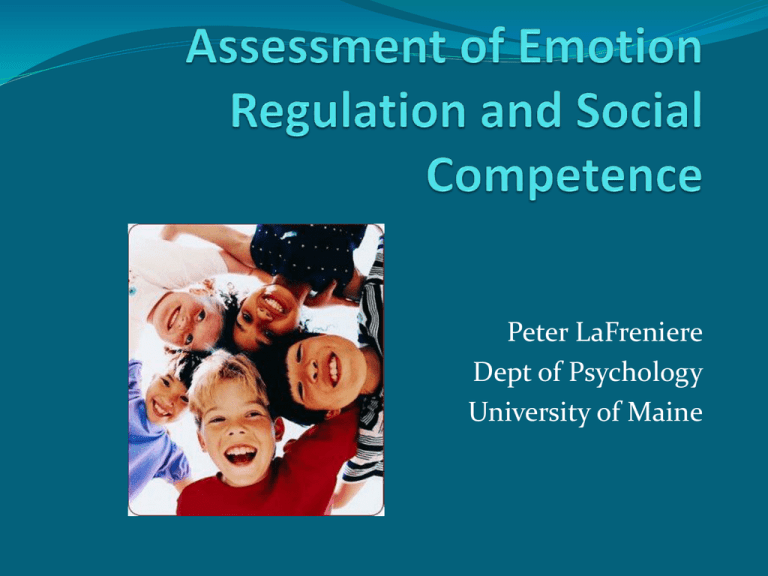
Peter LaFreniere Dept of Psychology University of Maine During the preschool years, researchers have consistently noted a gradual rise in social competence as children acquire greater cognitive and emotional maturity and self-control and a corresponding decline in angry outbursts and aggressive behavior. One of the first researchers to document age trends was Florence Goodenough who questioned mothers regarding these behaviors in a study conducted over 65 years ago. She described a developmental trend in which anger and aggression peaked at age two and steadily declined during the preschool years, though it remained more common in boys than girls. We recently conducted a study with an extensive sample using teachers as informants. Over 800 preschool teachers in 12 countries (United States, Canada, France, Italy, Austria, Russia, Finland, China, Taiwan, Spain, Mexico and Brazil) participated. They evaluated over 4000 preschoolers using the Social Competence and Behavior Evaluation Inventory (SCBE), a rating scale developed to assess patterns of social competence, emotion regulation and expression, and adjustment difficulties. Principal components analyses clearly identified three factors in all samples representing social competence, anxiety-withdrawal anger-aggression. This basic division between two broad types of emotional/behavioral disorders has been extensively verified in early childhood and adolescence. Let’s look under the hood… Social Competence and Behavior Evaluation Here is a list of behaviors that you may observe when the child is in your care. Circle the number that reflects the frequency of the behavior that you observe for the child. NEVER (1) SOMETIMES (2 or 3) OFTEN (4 or 5) ALWAYS (6). Social Competence Items Helps with everyday tasks (e.g., distributes snacks) Accepts compromises when reasons are given Takes pleasure in accomplishments Negotiates solutions to conflicts with other children Cooperates with other children Social Competence Items Takes other children and their point of view into account Comforts or assists another child in difficulty Shares toys Attentive towards younger children Works easily in group Anxious-Withdrawn Items Maintains neutral facial expression (doesn’t smile or laugh) Tired Worries Timid, afraid (e.g., avoids new situations) Sad, unhappy or depressed Anxious-Withdrawn Items Inhibited or uneasy in the group Inactive, watches other children play Remains apart, isolated from the group Doesn't talk or interact during group activities Goes unnoticed in a group Angry-Aggressive Items Easily frustrated Gets angry when interrupted Opposes the teacher's suggestions Irritable, gets mad easily Forces other children to do things they don't want to do Angry-Aggressive Items Hits, bites or kicks other children Gets into conflicts with other children Hits teacher or destroys things when angry with teacher Screams or yells easily Defiant when reprimanded From the standpoint of parents, teachers, clinicians and the children themselves, the most readily apparent type of adjustment problem to the preschool classroom involves an inability to tolerate frustration, regulate anger and control aggressive behavior. This type of problem is referred to as conduct disorder, externalizing behavioral problem or undercontrolled behavior, depending upon the theoretical orientation of the investigator. Anger-Aggression Scale Preschool equivalent of broad-band syndromes conduct disorder or externalizing symptoms. The items describe angry, aggressive, selfish, and oppositional behaviors. Emotion regulation and affective expression were shown to be as central as aggressive behavior to this scale. The item with the highest factor loading in all four US samples was "irritable, gets mad easily" and poor frustration tolerance and defiance were among the other high loadings. Children with extreme scores on this scale tend to express their negative emotions in ways that hurt or at least disturb others. They function poorly in social situations, where they require almost constant supervision, often to protect others from their outbursts. The angry-aggressive group was found to be the most interactive with peers, but also the most rejected, results that correspond precisely with theoretical expectations, since aggression is associated with peer rejection across a wide age span. Boys were rated higher on this scale than girls and younger preschoolers were rated higher than older preschoolers. These gender differences were replicated in every culture. Age differences were found in many cultures, but not in Japan and Italy. Anxious-Withdrawn The second basic type also has a long history of investigation and is referred to variously as affective disorder, internalizing behavioral problem or overcontrolled behavior. Children who illustrate this second type of problem often withdraw from social contact in the face of distress or high levels of emotional arousal and may inhibit behavioral and emotional expression when aroused. The anxiety-withdrawal scale of the SCBE is composed of items describing anxious, depressed, isolated, and overly dependent behavior. The emotional items on this scale describe a child who is often sad, worried, timid, afraid and who rarely smiles or laughs during play with peers. The anxious-withdrawn group was observed to be significantly less interactive than all other groups, but not rejected by their peers. These preschoolers spent much of their time in activities on the periphery of group life, such as onlooking and parallel play, and were also prone to be alone and unoccupied. Children with extreme scores on this scale are seen by their teachers as sad, depressed, tired and worried, as well as isolated. They show little interest in the activities,tend to have a poor self-image and show high levels of immaturity, as they often seek adult attention in situations that do not require it, and find it difficult to perform tasks within their capabilities without regular assurance, giving up easily where others would persist. There were no gender differences on this scale. This was replicated in every culture. Age differences were slight, with younger children scoring higher than older children. This pattern was replicated across culture, except China. Social Competence This scale of the SCBE taps a broad range of behaviors designed to assess the positive qualities of the child's adaptation. Refers to behaviors that indicate a well-adjusted, flexible, emotionally mature and generally prosocial pattern of social adaptation. The emotional items on this scale emphasize emotion regulation, including the child’s ability to remain calm during conflict, show pride and pleasure in their own accomplishments, accept compromises cheerfully, and demonstrate empathic awareness of other children’s needs and goals. The socially competent group received the most positive nominations and the least negative nominations from peers, and was highest in sociometric status. score high on assessments of ego resiliency show cooperation and affective-perspective taking express high levels of positive affect and relatively low levels of negative affect, are appreciated by their teacher. Boys were rated lower on this scale than girls and younger preschoolers were rated lower than older preschoolers. These gender differences were replicated in every culture. Age differences were also replicated across culture. Attachment theorists have proposed that patterns of co-regulation established within early social relationships provide an internal working model (IWM) for later social relations (Bowlby, 1980; Sroufe, 1996). Because the attitudes, expectations and interpersonal skills that the child acquires are carried forward and reintegrated into emerging developmental contexts (LaFreniere & Sroufe, 1985). Competence in one developmental period tends to promote adaptation within that period, while preparing the way for the formation of competence in the next. (Sroufe & Rutter, 1984). Because homeostatic mechanisms are inherent to both the family system and the attachment subsystem, family environment and quality of attachment tend toward stability, though early deviations are likely to result in greater disturbances later on (Cicchetti, 1990). The child who shows persistent deviations may be assumed to be involved in a continuous maladaptive process. A transactional model implies that a stable manifestation of maladaptation depends on environmental support, while the child's characteristics, reciprocally, partially determine the nature of the environment (Cicchetti & Schneider-Rosen, 1986). Central questions for developmental psychopathology have to do with where such stability resides and how positive change may be realized. Attachment theorists believe that the child's representational model of the attachment figure is closely interwoven with the child's emerging self concept, and the child's representation of relationships. Bretherton argues that ¨if an attachment figure frequently rejects or ridicules the child's bids for comfort in stressful situations, the child may come to develop not only an internal working model of the parent as rejecting but also one of himself as not worthy of comfort or help.¨ Alternatively, if a child experiences the attachment figure as trustworthy, loving and sensitive, the child is likely to form a related model of the self as lovable and worthy of help and comfort from others. IWM’s are thought to guide the processing of social information, as well as the child's beliefs, attitudes and feelings about the self and expectations regarding relationships. Although IWM’s remain open to new input as the child encounters new people, they nevertheless tend towards stability because the child actively selects partners and forms new relationships that fit the existing model. According to Bowlby, an IWM will be resistant to change once it is initially constructed, since it tends to operate outside the child's conscious awareness and because new information is assimilated to the existing model (Bowlby, 1980). In a new social milieu the child actively elicits confirmation of the IWM, while often ignoring or discounting counter evidence. Such "self-fulfilling" prophecies may bias a development by creating pathways that originate with the caregiver's behavior towards the child. Toddler Period Developmental theorists such as Ainsworth (Ainsworth et al, 1974), Erikson (1963), Kopp (1982), and Sroufe (1996) view the toddler period as critical for the development of an autonomous self-system, capable of independence and initiative, as well as responsiveness and conformity to rules and expectations of others. Human evolution is rooted in the basic primate patterns of group living involving elements of both cooperation and competition, and the care of children in all cultures changes dramatically at this age by presenting the child with a wider variety of social partners than during infancy. Despite this increased diversity of social partners, central developmental tasks for this period still involve changes in the ongoing relationship with the primary caregivers. Attachment theorists believe that child’s capacity for emotion regulation is shaped within the child's closest relationships. Sroufe (1996) employs the term guided selfregulation to capture the intermediate position of the toddler, between the earlier stage when the dyadic-regulation provided mostly by the caregiver predominates, and the later stage when the preschooler achieves true self-regulation. In this intermediate stage, toddlers are learning how to regulate their own emotions and behavior within the limits and guidelines provided by their caregivers. Two important influences on the dynamics of this learning process have been clarified by research: the overall quality of the parent's approach to discipline during the toddler period is more important than any specific childrearing practice, 2) attachment history has a profound impact on the transition towards more autonomous functioning. 1) Substantial evidence demonstrates a link between parenting styles involving warmth and control and later child outcomes though genetic factors, particularly gene-environment interactions may underlie these associations. In this research variables are often formulated to index qualitative dimensions of parenting that operate across a wide range of different contexts. Sroufe and colleagues view emotional support and quality of assistance as key aspects of parental competence. Their approach involves different problem-solving situations, each presenting the parent-toddler dyad with a unique challenge. The 1st situation involving free play is minimally challenging, particularly with respect to the issue of autonomy. The 2nd situation, in which the parent was instructed to interrupt the child's play at a prearranged signal and get them to put away the toys is designed to test how smoothly the pair could accommodate a potential conflict of wills. The 3rd situation involved a graded series of physical problems presented from the simplest to the most difficult to assure that all children would be taxed beyond their capabilities to solve the problem. This procedure is designed to assess the flexibility of the parent-child dyad, including parental support and guidance, and the child's emotion regulation and motivation. Toddlers with a history of secure attachment with their mothers were found to be more enthusiastic in this context, expressing more positive affect and less frustration, and were more successful, by virtue of their greater persistence, flexibility and cooperation. Toddlers with a history of anxious attachment showed different patterns of maladaptation. An earlier pattern of anxious-resistant attachment was associated with poor emotional regulation. These toddlers were often clingy, and easily prone to emotional dysregulation, becoming frustrated and/or oppositional in the cleanup and problemsolving situations. Toddlers with an anxious-avoidant history were somewhat disengaged with the tasks, showing little pleasure or enthusiasm, and often ignoring their mothers' attempts to involve them. Historically, this research was important for demonstrating continuity in both the patterns of the child's emotional competence and maternal sensitivity across different developmental periods, at a time when researchers were questioning such continuites. Maslin and Bates (1983) also found that securely attached infants engaged in less conflict with their mothers at age two than toddlers with a history of insecure attachment. In particular, toddlers who were earlier assessed as anxious-avoidant were more prone to enter into conflict with their mothers. Reciprocally, their mothers were more restrictive and controlling. As with the attachment assessment, these studies reveal disturbances in the parent-child relationship, rather than problems that reside exclusively within the child. During the toddler years however, the tensions and problems experienced with the primary attachment figure may be carried forward into other adult-child relationships, It appears that the capacity for regulating affectively arousing stimulation is central to positive adaptation in both the family and peer system. For example, Easterbrooks and Lamb (1979) and Lieberman (1976) found secure attachment to be associated with positive, reciprocal exchanges with agemates at 18 months and three years, respectively. Preschool Period During the preschool years, basic patterns of attachment are transformed reflecting developments in language and cognition, as well as shifting issues in psychosocial adjustment. For the child experiencing a secure relationship, there is a new partnership with the caregiver that reflects these advances and allows for increased autonomy and initiative. Within the parent-child relationship, the secure strategy incorporates perspective-taking, mutual commun-ication of affect and desires and joint planning, however a number of deviations from this pattern are possible, (Crittendon, 1992; Sroufe, 1989). A transactional model casts the child as an active agent rather than a passive recipient of environmental input or a direct product of genetic determinism. A new social milieu, such as the preschool, may be constructed differently by different children according to their attachment history. Considerable evidence has established a direct link between an infant’s primary attachment relationship and peer relations. Compared to insecurely attached peers, securely attached preschoolers behave more positively towards their peers receive more positive behavior from them, are better liked by peers, enjoy more positive and synchronous friendships, are viewed by their teachers as helpful, cooperative, empathic and socially competent Minnesota Longitudinal Study Attachment history (12 and 18 months) has been related to emerging behavioral problems in preschoolers. Results indicated that for this high risk, inner city sample (n=180) behavioral problems were evident for: 85% of infants with stable insecure attachments, 60% with mixed attachments and 29% with stable secure attachments. The investigators then examined other risk factors in the home in order to discover why some securely attached infants showed later behavioral problems and other insecurely attached infants did not. Compared to securely attached infants without later problems, secure infants that did show problems had mothers who were less emotionally supportive and not as clear or consistent in their guidance and limit setting. Other evidence suggested that these mothers experienced more confusion and disorganized mood states during this period and were less involved with their child than mothers of secure infants without behavior problems. When children with an earlier history of secure attachment were subsequently exposed to less than adequate maternal care and support, they were more likely to manifest behavior problems than secure infants in stable caregiving environments. Similarly, anxiously attached infants could become well-functioning preschoolers if their caregivers responded adequately to their needs during later developmental stages Anxious-resistant risk factor for internalizing behavior problems, including anxiety, high dependency on adults, social withdrawal, passivity, submissiveness with peers As infants and toddlers they were observed to be wary, easily upset, and difficult to settle. They were also characterized by a poverty of exploration and at times they showed explicitly angry, tantruming behavior, all presumably based on a history of inconsistent or chaotic care. Later they were found to become low-status, peripheral members of their preschool peer group three years later. Some of these children exhibited extreme passivity and an infantile dependence on adults, while others were more forward with their peers, but became easily over aroused and disorganized in the face of minor frustrations. Anxious-avoidant The adoption of an avoidant behavioral style in order to cope with chronic insensitivity and rejection by their primary caregiver may lay the foundation for a defensive personality characterized by hostility and negative expectations of others. Preschoolers with anxious-attachment histories were found to express more hostility and negative affect towards their peers, and were more rejected by them than securely attached children. Researchers have also found that preschoolers with a history of avoidant attachment appear to be vulnerable to externalizing problems which may be expressed in relational aggression. In free play sessions, a high percentage of children with avoidant histories took advantage of and mistreated their play partner. In all cases of victimization the "exploiter" had an avoidant history, while the victim often had a resistant history. Preschool teachers often have distinct emotional reactions to children with different attachment histories. Several studies have shown that they often nurtured and protected children with resistant histories, but sometimes reacted with anger to the open defiance and bullying of children with avoidant histories. These distinct emotional responses on the part of new caregivers underscore the transactional nature of these early emotional disorders. Disorganized pattern Main and Solomon (1990) believe that these children respond to internal conflict by displaying contradictory or incomplete behavior patterns formed in response to chronic abusive or frightening parental behavior. As preschoolers, they appear to be inflexible and controlling, possibly as an attempt to bring some semblance of order to an otherwise chaotic network of close relationships. This pattern may also involve a role reversal between parent and child in caregiving and punishment. Such behaviors are believed to be mediated by deviant patterns of emotional regulation and communication in the parent-child relationship. Developmentally Appropriate Practice From the National Association for the Education of Young Children, 2009. Developmentally Appropriate Practice 1. Creating a caring community of learners 2. Teaching to enhance development and learning 3. Goal oriented curriculum 4. Assessing children’s development and learning 5. Establishing reciprocal relationships with families. - National Association for the Education of Young Children, 2009

